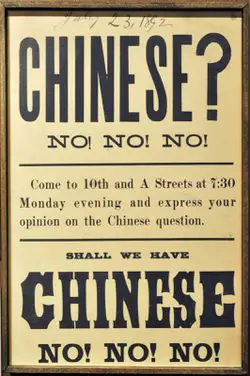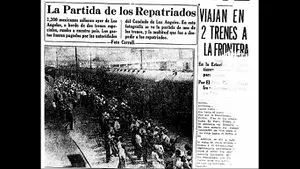How have immigration and citizenship changed in the U.S.
Throughout the colonial period, migration to the American continent was an open process. The desire to create permanent settlements prevented the creation of immigration restrictions during the 17th and 18th centuries. It wasn’t until after America became its own independent nation that it began to grapple with issues of citizenship and immigration.
Who is an American?
From the beginning, America was an experiment. Never before had a nation been created from such a heterogeneous population. Individuals like Michel-Guillaume-Jean de Crèvecoeur described the “American” in 1782 as European or the descendant of a European, which resulted in a “strange mixture of blood, which you will find in no other country.” Crèvecoeur explained that it was common to find families where the “grandfather was an Englishman, whose wife was Dutch, whose son married a French woman, and whose present four sons have now four wives of different nations… Here [in America] individuals of all nations are melted into a new race whose labors and posterity will one day cause great changes in the world.”[1] While Crèvecoeur may have been impressed by the sheer “heterogeneity” of the American family, it was clear that it was characterized by purely European ancestry. The earliest immigration and naturalization laws would reflect a desire to protect the relationship between whiteness and American identity.
The very first census and naturalization law emerged in the United States in the same year: 1790. Moreover, they both shared a commonality: the word “white.”
The first census recorded males heads of households, free white males over the age of sixteen, free white males under the age of sixteen, free white females, all other free persons (by sex and color), and slaves. Additionally, the Constitution gave congress the power to establish a uniform naturalization system that manifested in the Naturalization Act of 1790. According to this Act, only “free white person[s]” of good character who had resided in the U.S. for two years could become citizens of the United States.[2] Though it clearly restricted citizenship to others of European ancestry, the Founding Fathers considered this an open immigration policy.
From 1790 through the passage of the 14th Amendment (which established birthright citizenship), whiteness would define the limits of American citizenship. Additionally, for decades, no non-white immigrant could become a naturalized citizen of the United States. It was only until the 1940s that persons of Asian origin could become eligible for naturalized citizenship.
The Naturalization Act was modified again in 1795, and in 1798—each time increasing the residency requirement for citizenship. 1798 also saw the passage of the Alien and Sedition Acts. These Acts, which were passed under a Federalist administration, were designed to restrict free speech, and made it easier for the government to deport foreigners. President John Adams supported these laws because of concerns he had about French radicalism penetrating the United States. Under the assumption that foreigners brought radicalism and disquiet, these laws also made it harder for new immigrants to vote.
19th Century
The first half of the 19th century was relatively quiet in relation to immigration and citizenship milestones. However, there were two that would have a significant impact on American history: the Treaty of Guadalupe Hidalgo (1848) and the Dred Scott decision (1857). The Treaty of Guadalupe Hidalgo ended the Mexican-American war. Under the terms of the treaty, Mexico ceded the territories of present-day New Mexico, Nevada, California, and part of Utah to the United States. In return, the United States would pay Mexico $15 million dollars, and would bestow U.S. citizenship to the Mexican citizens in the regions that had just been ceded. There was uproar about the incorporation of millions of Mexican nationals into the folds of American citizenship (since citizenship was still limited to whites).
While the United States was embroiled in conflict with Mexico, Dred Scott, a slave, sued for his freedom. Scott’s master was a surgeon, and Scott was forced to accompany him during some of his travels. In the course of these travels, he visited Illinois (a free state) and the Wisconsin territory. Scott sued because he believed that his residence in a free state had freed him. After about ten years of appeals, his case made its way to the U.S. Supreme Court. The decision was read in March 1857. Rather than simply state that Scott was a slave, Chief Justice Roger B. Taney stated in the majority opinion that blacks were not citizens, and could not sue. Cementing that the rights and privileges of citizenship were reserved for white Americans.
In 1875, Congress passed the Page Act. The Page Act signaled a shift in American immigration policy. Rather than define who could come in to the United States, this act sought to define who could not come to the United States. The Page Act—often neglected in the study of American immigration laws—was, in many ways, a precursor to the more frequently studied Chinese Exclusion Act of 1882. After the completion of the Transcontinental Railroad, anti-Chinese hostility rose throughout the U.S. but became much more visible in the West Coast. Chinese laborers, who had been instrumental to the completion of the rail, were now seen as foreign competition for scarce jobs.
The Page Act prevented the immigration of anyone from “China, Japan, or any Oriental country” who was coming into the United States for contract labor. It also sought to ban single women from these countries from entering the United States because it was feared these women were entering the U.S. for immoral purposes (like prostitution). The Act, therefore, was justified as something to protect American families and homes by eliminating coolie labor competition (thereby protecting an American standard of living) and preventing prostitutes from seducing American men and introducing foreign diseases to the nation.
The Chinese Exclusion Act followed the Page Act, in 1882, which was the first immigration law to target individuals because of race. It excluded Chinese laborers, but did not prevent wholesale immigration of Chinese to the U.S. It did allow for exceptions for “qualified” immigrants. However, since the Act excluded “skilled and unskilled laborers” and those in the mining industry, it meant that very few Chinese were actually allowed to enter. This Act was renewed in 1892 as the Geary Act and remained in effect until 1943 when wartime conditions (specifically, the fact that the U.S. was allied with China) justified the repeal of the Chinese Exclusion Act and subjected Chinese Immigration to a quota limit.
20th Century
In the 20th century, Immigration Acts (1903, 1906, 1917, 1918) and Naturalization Acts (1906) continued to circumscribe the limits of American identity. These immigration acts declared those with certain diseases inadmissible, and created an Asiatic Barred Zone (1917). From the Page Act through 1918, the focus was on the type of immigrants entering the United States—hence, an era of “qualitative” immigration restriction. This would change, in 1924 with the passage of the Johnson-Reed Act, or the Immigration Act of 1924, and would move the U.S. into an era of quantitative restriction.[3]
In the 1920s, William Dillingham, a Vermont Senator, introduced the quota system to restrict immigration. According to his original suggestions, the U.S. would issue 350,000 new visas per year at a quota of 3% of the nationalities present in the 1910 census. President Wilson opposed it, but President Harding passed it when he was elected. In 1924, when the law needed to be reviewed, the quota system was simply adjusted. For the Johnson-Reed Act, the quota system was based on 2% of the population of the nationalities present in the 1890 census. This was an explicit attempt to preserve U.S. racial homogeneity, as the 1890 census would have fewer individuals from Southern and Eastern Europe—the people of which most Americans considered members of distinct and inferior races.
Though the Johnson-Reed Act did not impose quotas on immigrants from the Western Hemisphere (due in large part to agribusiness demands in the American Southwest), it was clear that immigrants from Mexico, in particular were not desirable. When the Depression reached its nadir, individuals of Mexican ancestry—whether citizen or not—were targeting with much of the same hostility that the Chinese experienced in the late 19th century.
However, rather than simply restrict Mexican immigration, Americans recognized that their solution was right across the border. Using rhetoric that suggested that all Mexicans were immigrants, many states embarked on a massive deportation campaign referred to euphemistically (and erroneously) as “repatriation” (since approximately 60% of those deported were American citizens). The desire or acceptance of Mexicans in the United States hinged upon labor demands. When World War II pulled America out of the Great Depression, suddenly, Mexican labor was crucial again and led directly to the Bracero Program.
In 1952, the Immigration and Nationality Act (or McCarran-Walter Act) was passed. This act upheld the national origin quotas, but also ended Asian exclusion. The decision to retain immigration quotas was based on concerns about communist infiltration and the threat of communist immigrants to the foundations of American society. The quotas in the McCarran-Walter Act were set at one-sixth of one percent of each nationality’s population in the 1920 census. It continued with the tradition of excluding Western Hemisphere nations form the quota system. The Act also focused on family reunification and prioritized immigrants with special skills. Which are policies that remain to this day.
Selected Suggested Readings
Bernard Bailyn, The People of British North America: An Introduction, New York: Vintage Books, 1986.
Eithne Luibheid, Entry Denied: Controlling Sexuality at the Border, Minneapolis: University of Minnesota Press, 2002.
Mae M. Ngai, Impossible Subjects: Illegal Aliens and the Making of Modern America, Princeton: Princeton University Press, 2004.


